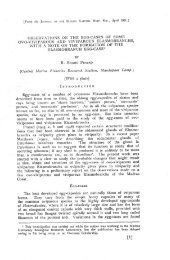PDF - Eprints@CMFRI
PDF - Eprints@CMFRI
PDF - Eprints@CMFRI
You also want an ePaper? Increase the reach of your titles
YUMPU automatically turns print PDFs into web optimized ePapers that Google loves.
74<br />
Dis t rib ut a tiD n : Red Sea; Somaliland ; Providence Isis.; Aldabra; Reunio n; Mauritius; Maldives;<br />
Palk Bay; Ceylon; Mergui Archipelago (DUNCAN , 1889).<br />
Superfamily Fungiicae DANA, 1846<br />
Family Fungiidae DANA , 1846<br />
Key to the genera of the fa mily Fungiidae from Red Sea:<br />
A. Corallum discoidal, axial fossa short and monocentric, frec at adult stage.<br />
I. Corallum not more than 5 cm in diameter. Disc imperforate. Costae and septa with small grainlike<br />
teeth ....... . . .. . .............. . ............ . ........ .. .......... Cycloseris<br />
2. Corallum larger than in I ., sometimes oval. Septa and costae pro minently dentate. Rarely secondary<br />
mouths are developed at the oral side . .. . ... . ........ . .. ... . .. . .. ............. Fungia<br />
B. Corallum elongare, with a long axial furrow, free at adult stage.<br />
3. The axial furrow mono- or polycentric. Septa alternating in size. Septa of lower cycles run uninterrupted<br />
from the axial furrow to the periphery of the coraHum. No lateral calices . ....... Ctenaetis<br />
4. The axial furrow always polycentric. Septa short, those originating from t he axial fossa never<br />
reach the periphery of the corallum . La teral calices present. ... ..... . ....... . . .. Herpolitba<br />
C. Corallum foliaceous, plate- or bowl-shaped, and fixed in ad ult stage.<br />
; . Second ary calices numerous. ...... .. ... .. .......... . ................. .. . Podabaeia<br />
Genus Cycloseris MIL E EDWARDS and HAIJ\I E, 1849<br />
Type s species : Fungia eyclolites LAMARCK , 1801.<br />
G e n e ric c h a r act e r s: Solitary in adult stage. Discoidal or in diaseris form . Corallum imperforate.<br />
Very young stages in some species hexagonal. Costal granulation well developed. Adult ones ge nerally<br />
attain a size of more or less 5 cm in diameter.<br />
The six species discussed in this 1V0rk ca n be separated as follows:<br />
A. Corallum flat , thin. Scar of attachment often visib le .<br />
a) First two cycles of septa increase in height towards the centre of the disc and become highly<br />
exsert around the axial fossa .<br />
1. Septa comparatively thin, edges of septa sharp. Costae regularly radiating from the centre ....<br />
. . . . . . . . . . . . . . . . . . . . . . . . . . . . . . . . . . . . . . . . . . . . . . . . . . . . . . . . . . . . c. pa tel/ifomlis<br />
b) First two cycles of septa moderately increasing in height around the fossa. Costae low, at the<br />
margi nal part of the disc more distinctive.<br />
2. Septa comparative ly thick, edges of septa rounded ..... .. . ... . .. ........ C. doederleini<br />
3. Septa thin , edges of septa lacerated ... .... . ........ . . ... . .... ....... . .. C. ef erosa<br />
B. Corallum conical thick. Scar of attachment in most cases not visible. Major septa exsert.<br />
a) Costae alternating in size .<br />
4 . Corall um in cycloseris or diaseris form . Disc increasing in thickness towards the centre. Septa<br />
thickened , edges blunt, sides highly granular. Columella papillary .......... . ... C. distorta<br />
5. Corallum perceptibly oval, underside concave .. ' .. . " .. ... .. ......... .. . . C. eyclo/ites<br />
b) Costae equal in size .<br />
6 . Corallum circular, underside flat or slightly concave . .. ........... .. ...• . . . C. eostu/ata<br />
Cycloseris patel/ifon"is (BOSCHMA), 1923<br />
( Pl atr 16 , Fig. I)<br />
FunglQ<br />
Cycloseris<br />
patelliform is 1923. BOSC HMA . 136; pI. 919, II, 13 - 16a.<br />
1925 . 8 0SCHMA, 192; pl. 5/ 12- 14. 21.<br />
1952. CROSSLAND. 154 , pLl6Il.<br />
patelliform ;s 1954. WELLS, 447; pI. 157/ 1-3.
















